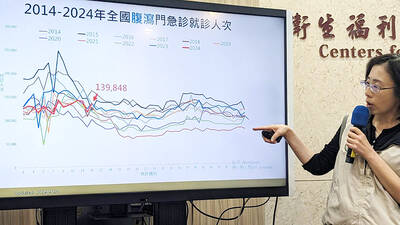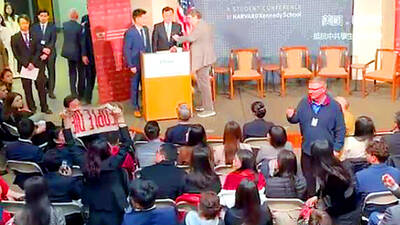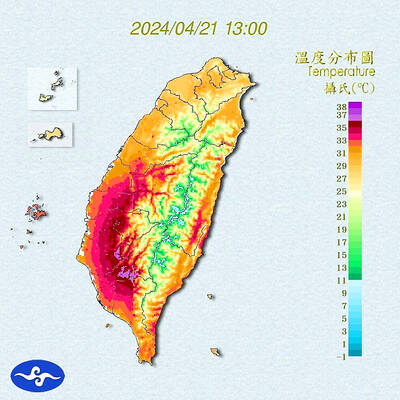Chinese Nationalist Party (KMT) Chairwoman Hung Hsiu-chu (洪秀柱) yesterday said she is worried about “cultural Taiwanese independence” that she said the Democratic Progressive Party (DPP) administration plans to promote after it takes office on May 20.
Hung said at a KMT Central Standing Committee meeting that with the DPP’s return to power and judging from remarks and the performances of incoming minister of culture Cheng Li-chun (鄭麗君) and incoming minister of education Pan Wen-chung (潘文忠), policies of “de-Sinicization” and “cultural Taiwanese independence” are certain to be perpetuated.
“The two sides of the Taiwan Strait would not only lose their common political ground, a split in cultural identity would also be further widened, which would lead to a total collapse of the basis of the cross-strait relationship,” she said, adding that the cross-strait relationship would become one based on the distinction between enemies and friends, which would be disadvantageous to Taiwan.
Hung said that the fruit of KMT governance in the past eight years is evident, citing the number of cross-strait agreements signed and meetings held.
“The economic and trade exchanges between the two sides have brought enormous economic benefits, with the accompanying ease of military tensions and scorched-earth diplomacy, while Taiwan’s security, prosperity and dignity have been maintained,” she said.
Hung said she has misgivings about the incoming DPP government’s ability to handle cross-strait problems, adding that the relationship would return to the same state as eight years ago, with economic exchanges dwindling, the number of Chinese tourists dropping, military matters becoming more tense and the diplomatic truce ending.
“The KMT is going to continue working on a cross-strait relationship that is based on the [so-called] 1992 consensus to maintain cross-strait stability, lest Taiwanese be negatively affected [by the DPP’s cross-strait policies],” Hung said, adding that the party’s task force handling mainland affairs would be upgraded to a department.
Separately, former premier Frank Hsieh (謝長廷), who has been named the nation’s next representative to Japan, clarified what a Japanese news outlet quoted him as saying.
According to a report, Hsieh said that president-elect Tsai Ing-wen (蔡英文) would not mention the “1992 consensus” or “the two sides of the Strait belonging to one China” in her May 20 inauguration speech.
“I did not put it that way,” Hsieh said of the report. “What I said was that according to the DPP’s logic and theory, we acknowledge that there was a meeting in 1992 and understand the spirit it represented, but we do not acknowledge the term ‘1992 consensus.’”
Former Mainland Affairs Council chairman Su Chi (蘇起) in 2000 admitted making up the concensus, which is a tacit understanding between the KMT and the Chinese Communist Party that both sides acknowledge there is “one China,” with each side having its own interpretation of what “China” means.
When asked about Beijing possibly demanding that Tsai acknowledge the “1992 consensus,” Hsieh said China would urge Taiwan to back down, as that is how the cross-strait relationship works.
“However, we of course would want to retain our sovereignty,” he said.
Hsieh added that insofar as Tsai is an elected president, she would have to draw her policies in accordance with public opinion.
“Her talk about the Republic of China’s constitutional framework was put forward following the wishes of the majority; this is sine qua non of a democratic country and also predictable,” he said.

FLU SEASON: Twenty-six severe cases were reported from Tuesday last week to Monday, including a seven-year-old girl diagnosed with influenza-associated encephalopathy Nearly 140,000 people sought medical assistance for diarrhea last week, the Centers for Disease Control (CDC) said on Tuesday. From April 7 to Saturday last week, 139,848 people sought medical help for diarrhea-related illness, a 15.7 percent increase from last week’s 120,868 reports, CDC Epidemic Intelligence Center Deputy Director Lee Chia-lin (李佳琳) said. The number of people who reported diarrhea-related illness last week was the fourth highest in the same time period over the past decade, Lee said. Over the past four weeks, 203 mass illness cases had been reported, nearly four times higher than the 54 cases documented in the same period

A group of Taiwanese-American and Tibetan-American students at Harvard University on Saturday disrupted Chinese Ambassador to the US Xie Feng’s (謝鋒) speech at the school, accusing him of being responsible for numerous human rights violations. Four students — two Taiwanese Americans and two from Tibet — held up banners inside a conference hall where Xie was delivering a speech at the opening ceremony of the Harvard Kennedy School China Conference 2024. In a video clip provided by the Coalition of Students Resisting the CCP (Chinese Communist Party), Taiwanese-American Cosette Wu (吳亭樺) and Tibetan-American Tsering Yangchen are seen holding banners that together read:

Heat advisories were in effect for nine administrative regions yesterday afternoon as warm southwesterly winds pushed temperatures above 38°C in parts of southern Taiwan, the Central Weather Administration (CWA) said. As of 3:30pm yesterday, Tainan’s Yujing District (玉井) had recorded the day’s highest temperature of 39.7°C, though the measurement will not be included in Taiwan’s official heat records since Yujing is an automatic rather than manually operated weather station, the CWA said. Highs recorded in other areas were 38.7°C in Kaohsiung’s Neimen District (內門), 38.2°C in Chiayi City and 38.1°C in Pingtung’s Sandimen Township (三地門), CWA data showed. The spell of scorching

UNAWARE: Many people sit for long hours every day and eat unhealthy foods, putting them at greater risk of developing one of the ‘three highs,’ an expert said More than 30 percent of adults aged 40 or older who underwent a government-funded health exam were unaware they had at least one of the “three highs” — high blood pressure, high blood lipids or high blood sugar, the Health Promotion Administration (HPA) said yesterday. Among adults aged 40 or older who said they did not have any of the “three highs” before taking the health exam, more than 30 percent were found to have at least one of them, Adult Preventive Health Examination Service data from 2022 showed. People with long-term medical conditions such as hypertension or diabetes usually do not